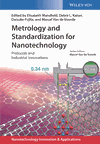Analytical Nanoscopic Techniques: Nanoscale Properties
Abstract
This chapter introduces the present status of key analytical measurement techniques for nanoscale properties, named “nanometrology” or “nanocharacterization”. It discusses the major players such as canning probe microscope (SPM) and transmission electron microscope (TEM) and the emerging nanocharacterization techniques, such as scanning helium ion microscope (SHIM), and nano-secondary ion mass spectrometry (nano-SIMS). The breakthrough in aberration-corrected electron optics for transmission electron microscopes enabled subatomic precision and made TEMs one of the most important tools for nanotechnology and nanocharacterization. Combined with X-ray or electron spectroscopies, electron microscopies can be very powerful techniques for chemical analysis of nanoscale properties. Electron probe microanalyzer (EPMA) is such an analytical tool for the nondestructive determination of the chemical composition and states of materials at the nanoscale. Combined with spin-polarized electron sources, spin-polarized low-energy electron microscopy (SP-LEEM) is developed, by which surface magnetic structures and dynamic magnetic processes can be imaged at nanoscale.



